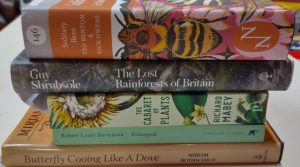Summer reading
The long hot summer provided time to catch-up on a pile of old favourites and new publications. Amongst the older ones were the Hon Miriam Rothschild’s ‘Butterfly Cooing Like A Dove’ (1991, Doubleday) which is a prolifically-illustrated exploration of the role and symbolism of butterflies in art; major works shown in full colour and black and white. Only Miriam could have done this extraordinary book with 30 chapters on such examinations on the soul, the spirit, the psyche, dreams and disasters, whilst quoting Nabokov, Prost, Jung and Picasso amongst many others.
As a fan of RLS I re-read Kidnapped – the cover reminding me that Stevenson is today the 25th most translated writer in the world. It is always enjoyable to read RLS’s glorious descriptions of people and places in Scotland in the 18th century. It is a pity that he was taken by TB at the age of 44. What other works did he have in prep.?
Botanical researcher, Richard Mabey’s ‘The Cabaret of Plants, Botany and the Imagination’ (Profile Books, 2016) is another firm favourite to dip into during the summer for his depth of knowledge of the English flora and its introduced species. His ‘Weeds’ (Profile, 2010) is an alternative good read.
Of newer titles, Guy Shrubsole’s ‘The Lost Rainforests of Britain’ (William Collins, 2022) – a Sunday Times Bestseller – follows on from his revelatory ‘Who Owns England’ (William Collins, 2018) gives us an insight into the temperate rainforests that we have in the West Country, west Wales and west of North England and west Scotland; these precious woodlands that need to be conserved. The amazing Wistman’s Wood on Dartmoor, dripping with lichens is for ever etched in one’s memory following a visit, but there are many more to explore and conserve. One hopes they must all be like that!
One of the more recent New Naturalist’s titles is ‘Solitary Bees’ (William Collins, 2023, No. 146 ) by Ted Benton and Nick Owens who know a thing or two about bees. Benton has already produced two other volumes in the NN series, Bumblebees (2006) and Grasshoppers and Crickets (2012). Owens has published books on bumblebees, bees and wasps. Together they have brought together a lot of theory and science behind the diversity of solitary bees which has not been previously set out. The large book (598pp) is lavishly illustrated throughout to show particular morphological features, nest construction and habitats. Solitary bees are not an easy group for any naturalist or general entomologist to get their head around the diversity and variation but this book presents all that is known of the group and will be a key work. Overall a good bunch of books perused over summer.
